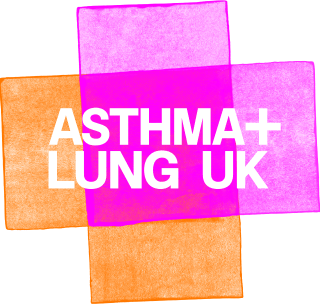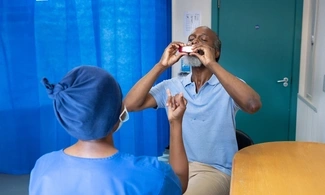Why does my patient need a bronchiectasis self-management plan?
In between regular bronchiectasis reviews, and if they have a flare-up, your patients need to know what to do to manage their bronchiectasis, take the right actions at the right time and lower the risk of a flare-up.
This self-management plan tells your patients:
- what they need to do every day to stay well
- what to do if their chest symptoms get worse
- how to recognise and manage a flare-up
- what emergency action to take if they feel very unwell.
Completing the plan with your patient and any carers: a section-by-section guide
Green section: My daily routine
This section tells you what actions your patient needs to take every day.
- Check they know what airway clearance techniques they should be using and why it’s important, even when they feel well. If your patient has not been seen by a respiratory physiotherapist, ensure you refer them.
- Explain what medications they have been prescribed so they know what each one is for and how and when to take it.
- If they use inhalers, check their inhaler technique.
- Check they are up to date with their vaccinations. Consider flu, pneumococcus, RSV, and COVID-19 if eligible.
- Encourage pulmonary rehabilitation. You can refer a patient with bronchiectasis if their MRC score is over 3
- If your patient smokes, refer for smoking cessation.
- Make sure they know maintaining a healthy weight will reduce the risk of flare-ups, and staying hydrated will reduce the viscosity of mucus, making it easier to clear their chest.
- Discuss how triggers such as pollution, allergy, damp and mould can make bronchiectasis worse and how triggers can be treated or avoided.
- Support their mental health and wellbeing and avoid isolation by referring to our helpline and online or in-person support groups.
Advice from my healthcare professional about managing my bronchiectasis
This box is for you to detail any other actions your patient should be taking every day, such as using an airway clearance device, taking prophylactic antibiotics or mucolytics, or using inhalers or nebulised medications.
Resources to help your patient manage their bronchiectasis
We have a lot of support for people living with bronchiectasis:
Amber section: When I feel worse
Use this section to help your patient recognise the early signs of a flare-up. Ask what changes they usually notice at the start of a flare-up, so you can tailor the plan to reflect their personal early warning signs.
Explain to patients that a bronchiectasis exacerbation is defined as a worsening of symptoms lasting ≥48 hours, which may include:
- increased cough
- increased sputum volume and/or purulence
- worsening breathlessness or fatigue
- fever above 38.8 degrees Celsius
- haemoptysis
- pleuritic chest pain.
Discuss with your patient what different sputum colours can indicate and identify what’s normal for them. This helps build their confidence to recognise changes early and take appropriate action or seek help when needed.
Red section: In a flare-up
This section will help your patient know what steps to take during a flare-up.
Make sure they know to contact their healthcare professional if their symptoms have worsened for ≥48 hours or if they’re worried. Tell them to ask for an urgent appointment, not a review appointment.
Advise them to bring a sputum sample to the GP surgery at the start of a suspected flare-up and ideally before any antibiotics are started. Make sure they have sputum pots at home for this purpose.
During a flare-up, your patient will need to increase their airway clearance or start doing it again if they haven’t been doing it. Explain that this is to stop infection worsening.
If I have an antibiotic rescue pack, I will start using it when:
Use this box to record when your patient should start a rescue pack and advise if they need to wait for sputum test results before starting antibiotics. Usually rescue packs should be started after ≥48 hours of worsening symptoms.
Advice from my healthcare professional about what I can do if I’m having a flare-up:
Add any other actions your patient should take whilst they’re having a flare-up, such as monitoring any other conditions they have. Remind them to rest, stay hydrated and eat little and often.
I will call 999 if I have any of these symptoms:
Safety net your patient by explaining what symptoms should prompt them to call 999.
Clearing my chest
Use this section to explain how often your patient should be clearing their chest both when they are well and during an exacerbation.
Document the type of techniques they should be using, such as the active cycle of breathing, gravity-assisted draining or an oscillating positive pressure device.
My bronchiectasis review
This section helps you to make sure your patient understands the importance of annual review or post-flare review and is a reminder of the key components.
At review:
- check treatment adherence and inhaler technique
- patients with ≥3 exacerbations/year, increasing symptoms, or poor response should be reviewed for specialist input
- review sputum microbiology, exacerbation frequency, and symptoms
- make sure your patient has been referred to respiratory physiotherapy for reassessment, if necessary, for example if their symptoms have worsened, they are finding it difficult to clear their chest or they have had exacerbations.
Help your patient make the most of their self-management plan
This self-management plan is designed to be an easy to refer to self-management tool for both your patient and other healthcare professionals who might provide care to them.
Once your patient’s plan is complete and up to date, save a copy to their notes. It’s important to replace any older plans with the latest version, so that primary care colleagues know what treatment your patient needs, especially during a flare-up. To help your patient use their plan effectively, you could:
- Advise them to keep a copy of their updated plan on their phone, tablet or laptop. You could email them an electronic version. If this is not possible, they could take a photo of the plan to keep on their phone. Remind them to replace it each time their plan is updated.
- Encourage your patient to keep a printed copy on their fridge or somewhere obvious, so it reminds them what they need to do to stay on top of their bronchiectasis.
- Suggest they share their self-management plan with family, friends and carers.
- Remind them to bring their plan along to every appointment.







